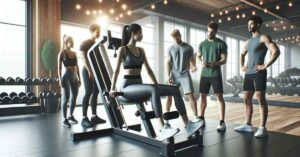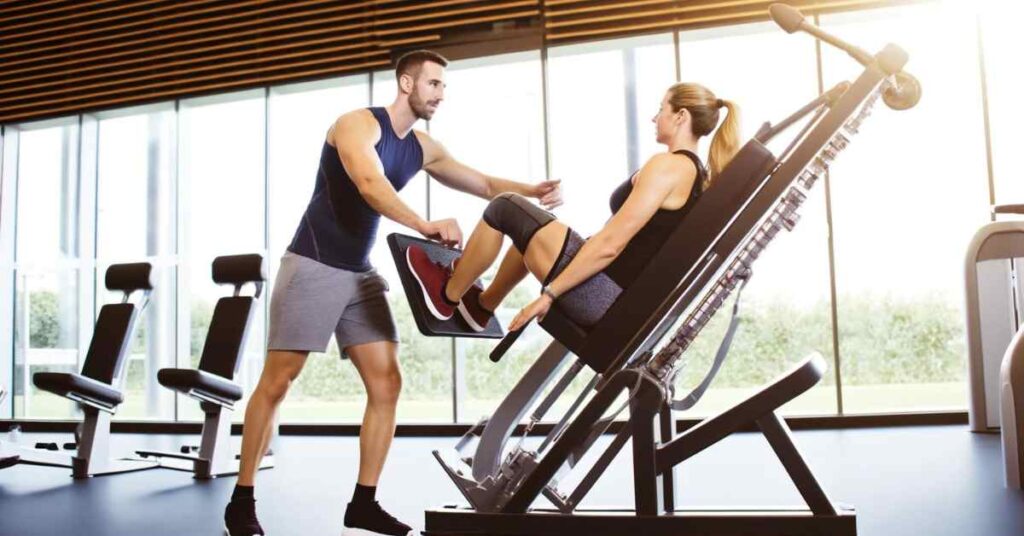Introduction to the Hip Thrust Machine
The hip thrust machine has become a cornerstone in modern fitness regimes, specifically tailored to enhance the strength and aesthetics of the glutes—muscles often overlooked in traditional lower-body workouts. Recognizing the critical role these muscles play in overall body strength, mobility, and stability, the hip thrust machine offers a focused approach to glute training that is both efficient and effective.
Understanding Hip Thrust Machines
Design and Functionality
At its core, the hip thrust machine is ingeniously designed to maximize the activation of the glute muscles. It typically features a padded bench and a loaded barbell setup, which users can adjust to fit their height and desired resistance levels. The machine’s ergonomic design ensures that users can perform hip thrusts with optimal form without the risk of the weights slipping or losing balance—a common issue in free-weight variations of the exercise.
Common Features
Standard on most models are adjustable pads and resistance settings, which accommodate users of all sizes and fitness levels. Some high-end models also integrate smart technology, such as rep counters and resistance trackers, to enhance training effectiveness and track progress.
Benefits of Using a Hip Thrust Machine
Targeted Muscle Development
One of the primary benefits of using a hip thrust machine is the targeted development of the gluteal muscles. The machine’s design isolates the glutes, allowing for concentrated muscle engagement. This focus helps in effectively increasing muscle size and strength, crucial for enhancing overall body aesthetics and performance in various sports.
Safety and Stability
The hip thrust machine is renowned for its safety and stability during workouts. Unlike free weights, where there is a risk of weights slipping or losing balance, the machine provides a secure environment that allows users to focus solely on the exercise. This stability is particularly beneficial for those who are new to hip thrusts or are looking to perform heavy lifts without assistance.
How to Use a Hip Thrust Machine Correctly
Setting Up for the Exercise
Before starting, it’s important to adjust the machine to fit your body. This includes setting the pad height to align with your back comfortably and adjusting the weight according to your fitness level. Ensuring the machine settings are correct before you begin helps prevent injuries and ensures the effectiveness of your workout.

Step-by-Step Usage Guide
- Sit on the ground with your upper back against the bench.
- Position the padded barbell over your hips.
- Plant your feet flat on the ground, spaced about shoulder-width apart.
- Drive through your heels to lift your hips towards the ceiling, pushing the barbell upwards.
- Pause at the top of the movement, ensuring your body forms a straight line from your shoulders to your knees.
- Lower back down smoothly and repeat for the desired number of reps.
Tips for Effective Training
Consistency is key in maximizing the benefits of the hip thrust machine. Aim for 2-3 sessions per week as part of your lower body training routine. Varying the rep range and weight can also help stimulate muscle growth and improve strength over time.
Integrating Hip Thrusts into Your Workout Routine
Frequency and Repetition Recommendations
Integrating hip thrusts into your workout regimen effectively requires attention to frequency and volume. For optimal results, aim to include hip thrust exercises two to three times per week. This frequency ensures adequate stimulation for muscle growth without overtraining. As for repetitions:
- Beginners should start with lighter weights, focusing on mastering the technique with higher repetitions, typically 12-15 reps per set.
- Intermediate and advanced users can increase the weight and vary their repetitions from high (10-12 reps) to low (4-6 reps) to maximize strength and hypertrophy gains.
Complementary Exercises
To create a balanced lower body workout, complement hip thrusts with other exercises targeting different muscle groups. Some effective exercises include:
- Squats and lunges for overall leg development
- Deadlifts for posterior chain enhancement
- Leg presses and hamstring curls for additional leg muscle isolation
Combining these exercises with hip thrusts ensures comprehensive lower body strength and aesthetics.
Choosing the Right Hip Thrust Machine for Your Needs
Home Gym vs. Commercial Gym Models
When selecting a hip thrust machine, consider where you will be using it:
- Home Gym: For home use, look for a machine that is space-efficient yet sturdy enough to support significant weight. Adjustable features are key for personal usage to accommodate different family members.
- Commercial Gym: In a commercial setting, durability and the ability to withstand heavy usage are paramount. Opt for machines with high weight capacities and robust construction to accommodate a wide range of users.
Key Features to Consider
When purchasing a hip thrust machine, prioritize the following features:
- Adjustability: Ensure the machine can be easily adjusted for different body sizes and weights.
- Comfort: Look for well-padded benches and ergonomic designs to enhance user comfort during workouts.
- Quality of Materials: Durable materials ensure longevity and safety.
- User Reviews: Research user reviews to gauge satisfaction and identify any common issues with the model you consider.
User Reviews and Feedback
Positive Experiences
Many users report significant improvements in glute strength and size after incorporating the hip thrust machine into their routines. The ability to use heavy weights safely is frequently praised, as well as the ease of use of the machines.
Points of Critique
Some users note the importance of having adjustable features to accommodate different body types and preferences. Others may point out the space requirements or the initial setup complexity as drawbacks, depending on the model.
Care and Maintenance of Your Hip Thrust Machine
Maintenance Tips
Regular maintenance is crucial for ensuring the longevity and safety of your hip thrust machine. Here are some key practices:
- Regular Inspection: Check all components, such as bolts and pins, for tightness and wear. Regularly inspect for any signs of damage or wear to the pads or structural components.
- Cleaning: Clean the machine regularly to remove sweat, dust, and other debris that could degrade materials over time. Use appropriate cleaners that won’t harm the machine’s surfaces.
- Lubrication: If your machine has any moving parts, ensure they are lubricated according to the manufacturer’s instructions to maintain smooth operation.
Troubleshooting Common Issues
- Noise: If the machine starts making unexpected noises, check for loose parts and ensure all moving components are well-lubricated.
- Instability: Ensure the machine is properly balanced and all adjustable parts are securely locked during use.
The Future of Hip Thrust Machines
Technological Advancements
The future of hip thrust machines looks promising with ongoing innovations aimed at improving user experience and training results. Potential advancements include:
- Integrated Technology: More machines may feature built-in tracking technology to monitor progress, such as the number of reps, range of motion, and force applied.
- Adjustability and Comfort: Expect further enhancements in ergonomics and adjustability, making machines more accessible to a broader range of body types and fitness levels.
Industry Trends
As awareness of the importance of targeted glute training continues to grow, hip thrust machines are likely to become more prevalent both in home gyms and commercial settings. Additionally, the focus on safe, effective workouts will continue to drive improvements in machine design and functionality.
Conclusion
The hip thrust machine is a valuable addition to any fitness regimen, particularly for those focused on building strength and improving the aesthetics of the lower body. By following proper usage guidelines and integrating this machine into your workout routine, you can significantly enhance your physical fitness and achieve your aesthetic goals. Regular maintenance will ensure that your machine remains a reliable part of your fitness journey for years to come.
FAQs
- How often should I use a hip thrust machine?
- For optimal results, include hip thrusts in your workout routine 2-3 times per week, adjusting the frequency based on your overall fitness goals and recovery.
- Can the hip thrust machine be used for exercises other than hip thrusts?
- While primarily designed for hip thrusts, some machines allow for variations like single-leg thrusts or even modified pelvic lifts, depending on their design and adjustability.
- What are the signs that I need to maintain my hip thrust machine?
- Listen for unusual noises, check for loose components, and look for wear and tear on pads and surfaces. These signs indicate that maintenance is needed.
- Is a hip thrust machine suitable for beginners?
- Absolutely, the hip thrust machine is excellent for beginners because it promotes correct form and reduces the risk of injury. Beginners should start with lower weights to master the technique.
- How do I choose the right hip thrust machine for my home gym?
- Consider factors like space, adjustability for different users, weight capacity, and durability. Also, read user reviews to understand the pros and cons of different models.

